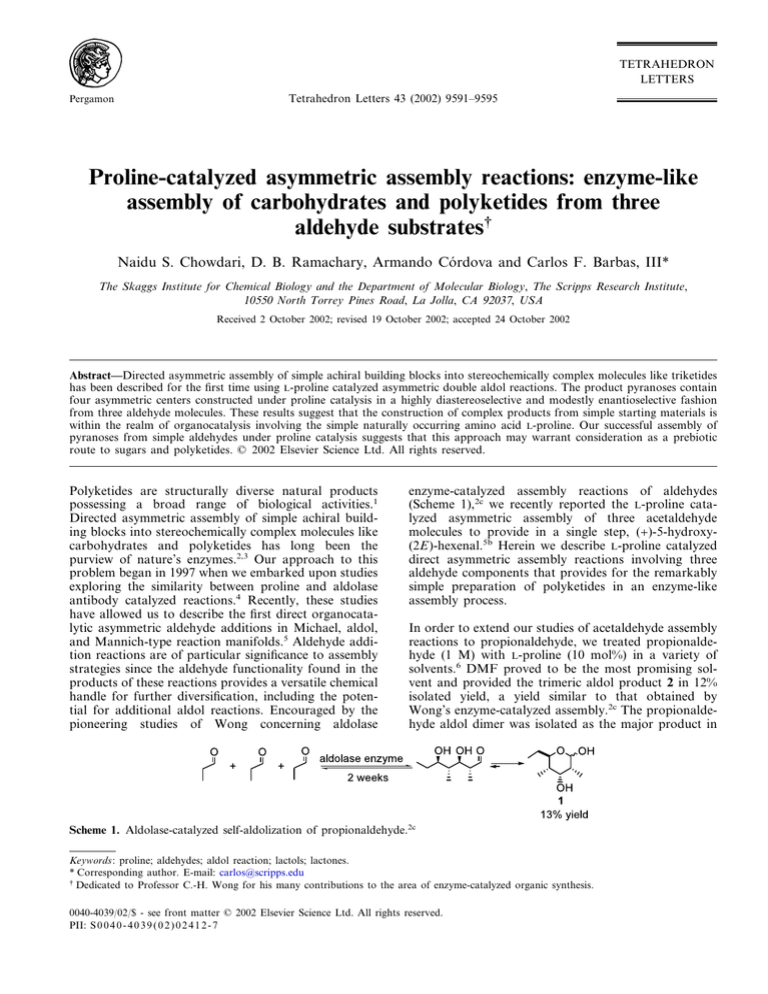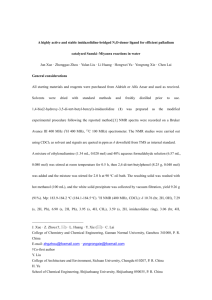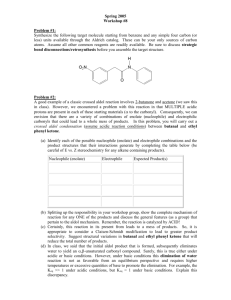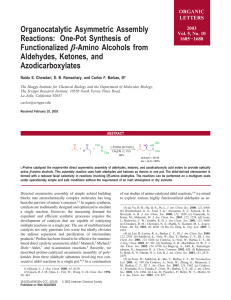
TETRAHEDRON
LETTERS
Pergamon
Tetrahedron Letters 43 (2002) 9591–9595
Proline-catalyzed asymmetric assembly reactions: enzyme-like
assembly of carbohydrates and polyketides from three
aldehyde substrates†
Naidu S. Chowdari, D. B. Ramachary, Armando Córdova and Carlos F. Barbas, III*
The Skaggs Institute for Chemical Biology and the Department of Molecular Biology, The Scripps Research Institute,
10550 North Torrey Pines Road, La Jolla, CA 92037, USA
Received 2 October 2002; revised 19 October 2002; accepted 24 October 2002
Abstract—Directed asymmetric assembly of simple achiral building blocks into stereochemically complex molecules like triketides
has been described for the first time using L-proline catalyzed asymmetric double aldol reactions. The product pyranoses contain
four asymmetric centers constructed under proline catalysis in a highly diastereoselective and modestly enantioselective fashion
from three aldehyde molecules. These results suggest that the construction of complex products from simple starting materials is
within the realm of organocatalysis involving the simple naturally occurring amino acid L-proline. Our successful assembly of
pyranoses from simple aldehydes under proline catalysis suggests that this approach may warrant consideration as a prebiotic
route to sugars and polyketides. © 2002 Elsevier Science Ltd. All rights reserved.
Polyketides are structurally diverse natural products
possessing a broad range of biological activities.1
Directed asymmetric assembly of simple achiral building blocks into stereochemically complex molecules like
carbohydrates and polyketides has long been the
purview of nature’s enzymes.2,3 Our approach to this
problem began in 1997 when we embarked upon studies
exploring the similarity between proline and aldolase
antibody catalyzed reactions.4 Recently, these studies
have allowed us to describe the first direct organocatalytic asymmetric aldehyde additions in Michael, aldol,
and Mannich-type reaction manifolds.5 Aldehyde addition reactions are of particular significance to assembly
strategies since the aldehyde functionality found in the
products of these reactions provides a versatile chemical
handle for further diversification, including the potential for additional aldol reactions. Encouraged by the
pioneering studies of Wong concerning aldolase
enzyme-catalyzed assembly reactions of aldehydes
(Scheme 1),2c we recently reported the L-proline catalyzed asymmetric assembly of three acetaldehyde
molecules to provide in a single step, (+)-5-hydroxy(2E)-hexenal.5b Herein we describe L-proline catalyzed
direct asymmetric assembly reactions involving three
aldehyde components that provides for the remarkably
simple preparation of polyketides in an enzyme-like
assembly process.
In order to extend our studies of acetaldehyde assembly
reactions to propionaldehyde, we treated propionaldehyde (1 M) with L-proline (10 mol%) in a variety of
solvents.6 DMF proved to be the most promising solvent and provided the trimeric aldol product 2 in 12%
isolated yield, a yield similar to that obtained by
Wong’s enzyme-catalyzed assembly.2c The propionaldehyde aldol dimer was isolated as the major product in
Scheme 1. Aldolase-catalyzed self-aldolization of propionaldehyde.2c
Keywords: proline; aldehydes; aldol reaction; lactols; lactones.
* Corresponding author. E-mail: carlos@scripps.edu
†
Dedicated to Professor C.-H. Wong for his many contributions to the area of enzyme-catalyzed organic synthesis.
0040-4039/02/$ - see front matter © 2002 Elsevier Science Ltd. All rights reserved.
PII: S 0 0 4 0 - 4 0 3 9 ( 0 2 ) 0 2 4 1 2 - 7
N. S. Chowdari et al. / Tetrahedron Letters 43 (2002) 9591–9595
9592
65% yield.7 Upon consideration of the relative reactivities of propionaldehyde and its dimer, we performed
the reaction by slowly adding propionaldehyde to the
reaction in an attempt to improve the yield of the
trimerized product. We were pleased to find that under
these conditions, trimeric products 1 and 2 could be
isolated in 53% yield as a 1:8 mixture of diastereomers
with an anomeric ratio of 1:2 (a:b) (Scheme 2).
Encouraged by our studies involving propionaldehyde
trimerization, we examined reactions involving
nonequivalent aldehydes. When 2 equiv. of propionaldehyde was added slowly over 24 h to acceptor
aldehydes such as isobutyraldehyde or isovaleraldehyde, the lactols 3 and 4 were formed as single
diastereomers in moderate yields (Table 1, entries 2 and
3). Further, no condensation products derived from the
trimers were formed in these reactions. The lactols were
cleanly isolated as 1:2 mixtures of a/b anomers. To test
the scalability of these types of assembly reactions, we
performed the propionaldehyde trimerization reaction
on a 10 g scale and found that the lactols could be
obtained in crystalline form in 50% yield.
Provided the significance of triketides as key building
blocks in natural products and drugs we were encouraged to convert our lactols to their corresponding d-lactones. Polyketides are typically synthesized via
biosynthetic assembly3 or chemical methods founded
on the aldol technology of Evans8a and Heathcock.8b
For example, Staunton’s expedient chemical syntheses
via the aldol approach provide triketide d-lactone products in seven steps.8c We found that we could readily
convert lactols 2–4 to their corresponding d-lactones
5–7 in quantitative yields using MnO2 as the oxidant.9
d-Lactones 6 and 7 were isolated as single
diastereomers and are thus assembled by proline in a
very highly diastereoselective manner. With respect to
enantioselectivity, d-lactone 5–7 were obtained in very
modest ee, 11–12% (entries 1–3).6 When we performed
the reaction at 4°C for 3 days, the product is formed in
30% yield with 33% ee. However, we found that the
product 2 formed after 10 h shows 47% ee. Thus, a
time-dependent decrease in the enantioselectivity of this
aldol assembly reaction occurs. Nonetheless, the
diastereoselective synthesis of d-lactones from three
simple aldehyde components could be achieved in only
two chemical steps.
Scheme 2. Proline-catalyzed self-aldolization reaction of propionaldehyde.14
Table 1.
L-Proline-catalyzed
assembly of pyranoses and their conversion to d-lactones15–17
N. S. Chowdari et al. / Tetrahedron Letters 43 (2002) 9591–9595
The stereochemistry of the lactols were determined by
NMR experiments of lactone 5 and comparison with
known compounds 1, 8 and 9.2c,7 The positive NOE
effect observed between C3(H) and C5(CH3) groups in
lactone 5 indicates the axial orientation of H and CH3
groups on C3 and C5 carbons, respectively (Fig. 1).
Hence, the stereochemical outcome of this self-aldolization assembly reaction is in accord with our previously
proposed transition-state model for proline-catalyzed
intermolecular aldol reactions.10 In contrast to the aldolase enzyme-catalyzed assembly reaction of propionaldehyde, where primarily a single product is
formed,11 the proline-catalyzed reaction afforded lactols
1 and 2, with 2 as the major product. The formation of
1 via 8 is readily explained by proline catalysis of two
sequential aldol reactions.2c,5b Major product 2, however, is formed from 9 through epimerization of the
intermediate propionaldehyde dimer 8. We verified this
experimentally by incubating 8 with L-proline. This
experiment confirmed that proline is capable of epimerizing the anti aldol dimer 8 to the corresponding syn
diastereomer 9.12 Reaction of the third aldehyde substrate, the slowest step in this reaction sequence, with
the syn aldol dimer provides lactol 2 as the major
product. Pyrrolidine was also studied as a catalyst of
this assembly reaction. In contrast to L-proline, pyrrolidine did not provide the products, confirming the role
of L-proline in directing the chemistry and diastereoselectivity of these assembly reactions (Scheme 3).
In conclusion, we have demonstrated for the first time
L-proline-catalyzed enzyme-like assembly of carbohy-
Figure 1. Selected NOEs for lactone 5.
Scheme 3. Proposed reaction pathway for the proline-catalyzed assembly of pyranoses.
9593
drates and polyketides. The product pyranoses contain
four asymmetric centers constructed under proline
catalysis with excellent diastereoselectivity and modest
enantioselectivity (47% ee) from three aldehyde
molecules. The identity of each aldehyde component
can potentially be freely varied providing access to a
wide range of molecules. This simple one-pot procedure
provides direct access to carbohydrates and polyketides
that are otherwise prepared using multi-step procedures. Furthermore, the reactions can be performed on
a multi-gram scale under operationally simple and safe
conditions. These results suggest that the assembly of
complex products from simple starting materials is
within the realm of organocatalysis involving the simple
naturally occurring amino acid proline. Our successful
assembly of pyranoses from simple aldehydes under
proline catalysis suggests that this approach may warrant consideration as a prebiotic route to sugars and
polyketides.13 Further studies aimed at exploring the
scope and increasing the enantioselectivity of these
proline-catalyzed assembly reactions are ongoing.
Acknowledgements
This study was supported in part by the NIH
(CA27489) and the Skaggs Institute for Chemical Biology. We thank Dr. D.-H. Huang and Dr. L. B. Pasternack for NMR assistance.
References
1. Khosla, C. J. Org. Chem. 2000, 65, 8129.
2. (a) Gijsen, H. J. M.; Wong, C.-H. J. Am. Chem. Soc.
1994, 116, 8422; (b) Gijsen, H. J. M.; Wong, C.-H. J. Am.
Chem. Soc. 1995, 117, 2947; (c) Gijsen, H. J. M.; Wong,
C.-H. J. Am. Chem. Soc. 1995, 117, 7585; (d) Gijsen, H.
J. M.; Qiao, L.; Fitz, W.; Wong, C.-H. Chem. Rev. 1996,
96, 443; (e) Koeller, K. M.; Wong, C.-H. Nature 2001,
409, 232; (f) Liu, J.; Wong, C.-H. Angew. Chem., Int. Ed.
Engl. 2002, 41, 1404.
3. (a) Kao, C. M.; Luo, G.; Katz, L.; Cane, D. E.; Khosla,
C. J. Am. Chem. Soc. 1994, 116, 11612; (b) Kinoshita, K.;
Willard, P. G.; Khosla, C.; Cane, D. E. J. Am. Chem.
Soc. 2001, 123, 2495 and references cited therein; (c)
Khosla, C.; Harbury, P. B. Nature 2001, 409, 247; (d)
Wu, N.; Kudo, F.; Khosla, C.; Cane, D. E. J. Am. Chem.
Soc. 2000, 122, 4847.
4. Zhong, G.; Hoffmann, T.; Lerner, R. A.; Danishefsky, S.;
Barbas, C. F., III J. Am. Chem. Soc. 1997, 119, 8131.
5. (a) Betancort, J. M.; Barbas, C. F., III Org. Lett. 2001, 3,
3737; (b) Córdova, A.; Notz, W.; Barbas, C. F., III J.
Org. Chem. 2002, 67, 301; (c) Córdova, A.; Watanabe,
S.-i.; Tanaka, F.; Notz, W.; Barbas, C. F., III J. Am.
Chem. Soc. 2002, 124, 1866; (d) Córdova, A.; Barbas, C.
F., III Tetrahedron Lett. 2002, 43, 7749; (e) For L-proline
catalyzed aldehyde addition reactions reported by other
laboratories, see: Bogevig, A.; Juhl, K.; Kumaragurubaran, N.; Jorgensen, K. A. Chem. Commun. 2002, 620;
(f) Bogevig, A.; Kumaragurubaran, N.; Zhuang, W.;
Jorgensen, K. A. Angew. Chem., Int. Ed. Engl. 2002, 41,
1790; (g) List, B. J. Am. Chem. Soc. 2002, 124, 5656.
9594
N. S. Chowdari et al. / Tetrahedron Letters 43 (2002) 9591–9595
6. Acetonitrile and dioxane are also good solvents for this
reaction and the major product of the reaction was
formed in these solvents with 15 and 11% ee, respectively.
Significantly lower yields were obtained in THF, CHCl3,
toluene and DMSO.
7. This product was identical to that reported by MacMillan
and co-workers during the course of these studies. Their
report detailed their highly successful studies of prolinecatalyzed direct cross-aldol reactions involving two aldehyde substrates: Northrup, A. B.; MacMillan, D. W. C.
J. Am. Chem. Soc. 2002, 124, 6798.
8. (a) Gage, J. R.; Evans, D. A. Org. Synth. 1990, 68, 83; (b)
Raimundo, B. C.; Heathcock, C. H. Synlett 1995, 1213;
(c) Wilkinson, A. L.; Hanefeld, U.; Wilkinson, B.; Leadlay, P. F.; Staunton, J. Tetrahedron Lett. 1998, 39, 9827.
9. Mori, Y.; Suzuki, M. J. Chem. Soc., Perkin Trans. 1
1990, 1809.
10. (a) List, B.; Lerner, R. A.; Barbas, C. F., III J. Am.
Chem. Soc. 2000, 122, 2395; (b) Saktihvel, K.; Notz, W.;
Bui, T.; Barbas, C. F., III J. Am. Chem. Soc. 2001, 123,
5260.
11. Epimerization of aldol intermediates has been observed
in aldolase enzyme-catalyzed assembly reactions as well
and these reactions are not typically 100% stereoselective.
See Ref. 2b,c.
12. The ratio of dimers 8 and 9 in the proline-catalyzed
self-aldol reaction of propionaldehyde varies with reaction time. For example the anti/syn ratio after 10, 13, 72,
96 h found to be 4, 2.5, 1.7 and 1, respectively.
13. (a) Pitsch, S.; Eschenmoser, A.; Gedulin, B.; Hui, S.;
Arrhenius, G. Origins Life Evol. Biosphere 1995, 25, 297;
(b) Schwartz, A. W. J. Theor. Biol. 1997, 187, 523; (c)
Graaf, R. M. D.; Visscher, J.; Arrhenius, G.; Schwartz,
A. W. J. Mol. Evol. 1997, 47, 501.
14. Typical experimental procedure for the catalytic asymmetric assembly of 6-ethyl-3,5-dimethyl-tetrahydropyran2,4-diol (entry 1): A mixture of anhydrous DMF (2.5
mL), L-proline (10 mol%) and propionaldehyde (0.361
mL, 5 mmol) were stirred at 4°C for 10 h. To this
propionaldehyde (0.18 mL, 2.5 mmol) was added slowly
over 20 h and stirred at rt for an additional 42 h. Then,
half saturated NH4Cl solution and ether were added with
vigorous stirring, the layers were separated and the
aqueous phase was extracted thoroughly with ether followed by dichloromethane. The combined organic phases
were dried (Na2SO4), concentrated, and purified by flash
column chromatography (silica gel, mixtures of hexanes/
ethyl acetate) to afford the desired pyranoses 1 in 6%
yield (26 mg) and 2 in 47% yield (205 mg) with 11% ee as
a mixture of anomers. 1: Rf 0.42 (50% hexanes/ethyl
acetate); 1H NMR (400 MHz, CDCl3) (a:b=1:3.2): l
0.89 (d, J=7.2 Hz, 3H), 0.92 (t, J=7.2 Hz, 3H), 1.04 (d,
J=7.2 Hz), 1.08 (d, J=6.8 Hz, 3H), 1.41 (m, 1H), 1.54
(m, 1H), 1.76 (m), 1.82 (m, 1H), 1.93 (m, 1H), 3.04 (bs,
1H), 3.20 (bs), 3.65 (bs, 1H), 3.71 (t, J=2.8 Hz), 3.85
(ddd, J=8.4, 6.4, 2.4 Hz), 4.08 (d, J=6.4 Hz, 1H), 4.13
(dt, J=6.8, 2.4 Hz, 1H), 4.72 (d, J=6.0 Hz, a-CHOH),
4.98 (bs, 1H, b-CHOH); 13C NMR (100 MHz, CDCl3)
(a-anomer): l 10.32, 10.41, 24.94, 37.09, 38.43, 74.00,
75.90, 97.16; (b-anomer): l 0.14, 10.32, 13.21, 24.78,
32.15, 38.07, 65.67, 75.62, 96.46. 2: Rf 0.32 (50% hexanes/
ethyl acetate); 1H NMR (400 MHz, CDCl3) (a:b=1:2.2):
l 0.94 (m, 6H), 1.02 (d, J=7.2 Hz, 3H), 1.48 (m, 2H),
1.63 (m, 2H), 2.09 (m, 1H), 2.19 (m), 2.56 (bs, 1H), 2.95
(ddd, J=10.4, 8.0, 2.8 Hz), 3.01 (d, J=6.0 Hz), 3.41 (dd,
J=11.2, 4.8 Hz, 1H), 3.54 (ddd, J=10.8, 7.6, 2.8 Hz),
3.80 (dd, J=10.0, 4.8 Hz, 1H), 4.76 (dd, J=6.0, 2.0 Hz,
a-CHOH), 5.10 (bs, b-CHOH); 13C NMR (100 MHz,
CDCl3) (a-anomer): l 4.32, 9.41, 13.02, 25.12, 35.69,
40.32, 75.20, 78.94, 95.81; (b-anomer): l 9.18, 10.58,
13.18, 25.23, 36.41, 38.66, 71.19, 74.38, 97.00; HRMS for
C9H18O3Na (MNa+): calcd 197.1148, obsd 197.1147.
15. 6-Ethyl-4-hydroxy-3,5-dimethyl-tetrahydro-pyran-2-one
(5): Lactol 2 (23 mg, 0.132 mmol) was dissolved in ethyl
acetate (1.3 mL) and stirred with MnO2 (172 mg, 1.981
mmol) at rt. After 48 h the reaction mixture was passed
through a short column of silica gel with ethyl acetate.
The eluate was concentrated to afford the desired lactone
5 in quantitative yield. Rf 0.32 (50% hexanes/ethyl acetate); 1H NMR (400 MHz, CDCl3): l 1.03 (t, J=7.2 Hz,
3H), 1.06 (d, J=7.2 Hz, 3H), 1.27 (d, J=7.2 Hz, 3H),
1.61 (m, 1H), 1.80 (m, 2H), 1.92 (bs, 1H), 2.67 (dq,
J=7.2, 3.6 Hz, 1H), 3.74 (t, J=3.6 Hz, 1H), 3.76 (ddd,
J=10.8, 8.2, 3.2 Hz, 1H); 13C NMR (100 MHz, CDCl3):
l 9.38, 11.15, 15.99, 26.11, 38.96, 41.78, 75.76, 82.61,
174.53; HRMS for C9H16O3Na (MNa+): calcd 195.0992,
obsd 195.0990; [h]D=−12.0 (c 1, CHCl3). The enantiomeric excesses of the lactone 5 was determined by
HPLC analysis of the corresponding 3,5-dinitrobenzoate
ester. The lactone 5 (20 mg, 0.116 mmol), 3,5-dinitrobenzoyl chloride (82.128 mg, 0.348 mmol) and DMAP (85
mg, 0.696 mmol) in dichloromethane (116 mL) were
stirred at rt for 1 h to afford the corresponding 6-ethyl-4(3%,5%-dinitrobenzoyloxy)-3,5-dimethyl-tetrahydro-pyran2-one. 1H NMR (400 MHz, CDCl3): l 1.08 (t, J=7.6 Hz,
3H), 1.24 (d, J=7.2 Hz, 3H), 1.30 (d, J=6.8 Hz, 3H),
1.84 (m, 1H), 2.04 (m, 1H), 2.96 (dq, J=7.2, 4.0 Hz, 1H),
3.90 (ddd, J=10.8, 8.4, 2.8 Hz, 1H), 5.23 (dd, J=3.8, 2.2
Hz, 1H), 9.07 (d, J=2.4 Hz, 2H), 9.24 (t, J=6.0, 1H);
13
C NMR (100 MHz, CDCl3): l 11.60, 14.61, 15.86,
19.83, 29.32, 36.67, 37.46, 80.21, 84.95, 122.80, 129.35,
133.01,
148.74,
162.05,
172.73;
HRMS
for
C16H18N2O8Na (MNa+): calcd 389.0955, obsd 389.0958;
[h]D=10.2 (c 1, CHCl3); HPLC (Daicel Chiralpak ADRH, H2O/MeCN=52:48, 0.1% TFA, flow rate 0.8 mL/
min, u=254 nm): tR=15.03 min (minor), tR=22.55 min
(major).
16. Compound 6: Rf 0.42 (50% hexanes/ethyl acetate); 1H
NMR (400 MHz, CDCl3): l 0.95 (d, J=7.2 Hz, 3H), 1.05
(d, J=6.8 Hz, 3H), 1.07 (d, J=6.8 Hz, 3H), 1.26 (d,
J=6.8 Hz, 3H), 1.92 (m, 2H), 2.67 (dq, J=6.8, 4.0 Hz,
1H), 3.73 (dd, J=11.2, 2.0 Hz, 1H), 3.75 (t, J=3.6 Hz,
1H); 13C NMR (100 MHz, CDCl3): l 11.18, 14.58, 16.06,
19.95, 29.23, 38.84, 39.43, 75.68, 85.32, 174.70; HRMS
for C10H18O3Na (MNa+): calcd 209.1148, obsd 209.1145;
[h]D=−5.2 (c 1, CHCl3). The enantiomeric excesses of the
lactone 6 was determined by HPLC analysis of 6-isopropyl-4-(3%,5%-dinitrobenzoyloxy)-3,5-dimethyl-tetrahydropyran-2-one. 1H NMR (400 MHz, CDCl3): l 0.97 (d,
J=7.2 Hz, 3H), 1.12 (d, J=7.2 Hz, 3H), 1.22 (d, J=7.2
Hz, 3H), 1.29 (d, J=7.2 Hz, 3H), 1.96 (m, 1H), 2.16 (m,
1H), 2.95 (m, 1H), 3.87 (dd, J=9.6, 2.4 Hz, 1H), 5.27 (t,
J=3.0 Hz, 1H), 9.07 (d, J=2.4 Hz, 2H), 9.24 (t, J=2.0,
N. S. Chowdari et al. / Tetrahedron Letters 43 (2002) 9591–9595
1H); 13C NMR (100 MHz, CDCl3): l 11.61, 14.61,
15.86, 19.85, 29.33, 36.68, 37.48, 80.23, 84.97, 122.83,
129.36, 133.03, 148.78, 162.08, 172.76; HRMS for
C17H20N2O8Na (MNa+): calcd 403.1112, obsd 403.1120;
HPLC (Daicel Chiralpak AD-RH, H2O/MeCN=52:48,
0.1% TFA, flow rate 1.0 mL/min, u=254 nm): tR=
15.10 min (major), tR=18.90 min (minor).
17. Compound 7: Rf 0.42 (50% hexanes/ethyl acetate); 1H
NMR (400 MHz, CDCl3): l 0.88 (d, J=6.4 Hz, 3H),
0.93 (d, J=6.4 Hz, 3H), 1.05 (d, J=6.8 Hz, 3H), 1.27
9595
(d, J=7.2 Hz, 3H), 1.34 (m, 1H), 1.65 (ddd, J=14.0,
10.4, 3.2 Hz, 1H), 1.76 (m, 1H), 1.96 (m, 1H), 2.67 (dq,
J=7.2, 3.6 Hz, 1H), 3.74 (t, J=3.2 Hz, 1H), 3.83 (dt,
J=9.6, 2.0 Hz, 1H); 13C NMR (100 MHz, CDCl3): l
11.19, 16.00, 21.23, 23.64, 23.95, 38.91, 42.85, 42.88,
75.80, 79.70, 174.49; HRMS for C11H20O3Na (MNa+):
calcd 223.1305, obsd 223.1305. HPLC (Daicel Chiralpak
AD-RH, H2O/MeCN=60:40, 0.1% TFA, flow rate 0.8
mL/min, u=220 nm): tR=6.76 min (major), tR=8.92
min (minor).







